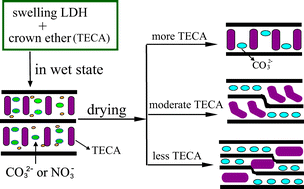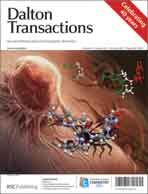The structural control involving staging formation was studied in the nanocomposites of macrocyclic tetraazacrown ether carboxylic acid derivative (TECA) and layered double hydroxide (LDH) obtained by an osmotic swelling/restoration process. After NO3-type MgAl–LDH was osmotically swollen in formamide, TECA was added, leading to a restoration of the LDH sheets and formation of TECA–LDH nanocomposites. In the wet state, the structure of the composites was homogenous, and the basal spacings of ∼2.0 or 1.8 nm were not changed by the water-washing process that removed formamide and caused the replacement of NO3− by CO32−. However, in the drying process, both the orientation of TECA in the interlayer and the formed staging structure varied with the TECA content. The TECA orientation changed from horizontal to tilted/twisted and finally to vertical with interlayer TECA density. The staging structure occurred for samples with both TECA and small inorganic guests coexisting in the interlayer. Third-staging, second-staging, and homogenous structures were observed at TECA/LDH weight ratios of low (0.125 and 0.25), medium (0.5) and large (1 and 2) values, respectively. The decrease of negative charge of TECA ions from −4 to −1 led to the co-existence of small ions (NO3−) with TECA in the gallery and the formation of a NO3−-containing staging structure, even at a high TECA/LDH ratio of 2. The study of the influence of CO32− on the composite structure indicates that a TECA/CO32− ion exchange progressed reversibly and the staging structure formed is thermodynamically stable, depending mainly on the chemical composition of the interlayer guests. The staging formation could be explained by the Daumas–Hérold model, which differs markedly from the Rüdorff model previously proposed for the LDH system. The treatment in formamide of the composite such as T2L+Na2CO3 with staging structure shows that the transformation process is reversible, and these kinds of composites may be used as an adsorbent for some harmful organic solvents.

You have access to this article
 Please wait while we load your content...
Something went wrong. Try again?
Please wait while we load your content...
Something went wrong. Try again?


 Please wait while we load your content...
Please wait while we load your content...